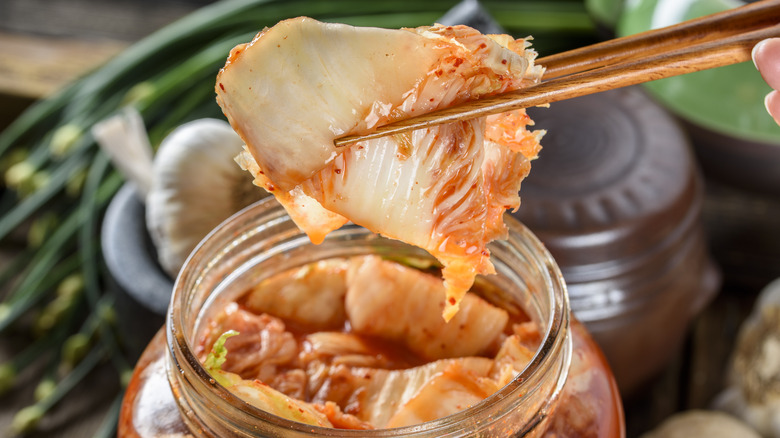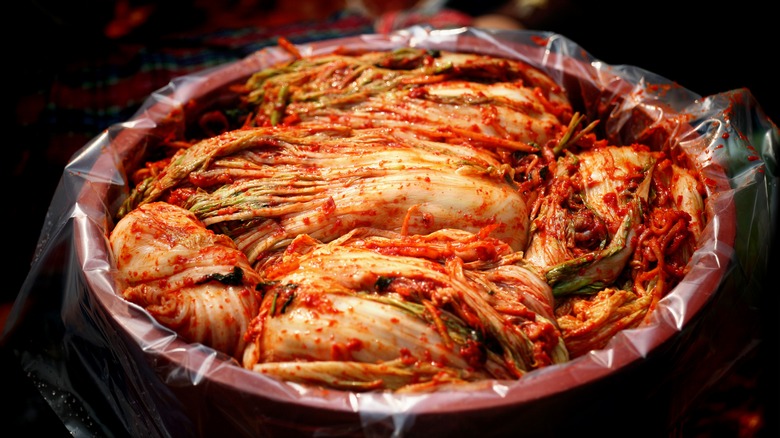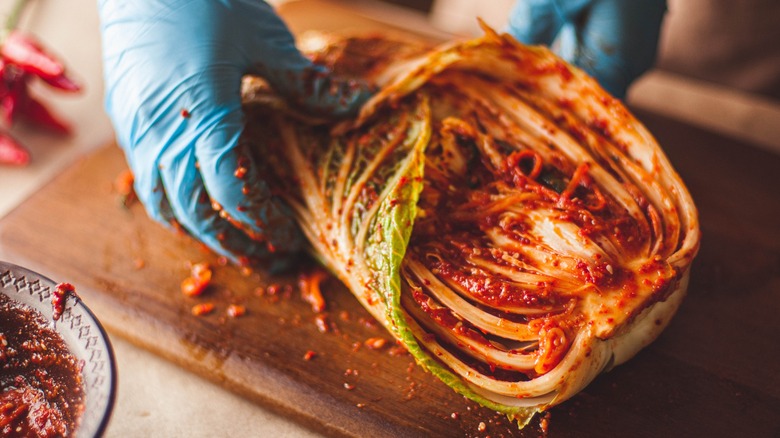How To Store Homemade Kimchi To Preserve The Flavor And Crunch
While kimchi is a fermented food and hence has a long shelf life, its quality is dependent on how it's stored. Improper storage methods can cause it to go bad, or spoil its flavor and appetizing crunch. The easiest way to keep kimchi from spoiling is to put it in your freezer. This will help to slow down the fermentation and keep out nasty bacteria. But this method ruins the texture of the cabbage, so it's better to simply keep it refrigerated.
Since Kimchi is fermented, it has an entire colony of good bacteria that are working away to create chemical reactions and fight off potential bacterial invaders. They also help develop kimchi's flavor more over time but do most of their work at warmer temperatures. By storing your kimchi in the refrigerator, you will slow down the fermentation process, and help keep the flavor and texture consistent for months or even up to a year.
It's also important to keep air out of the container. If you plan to make a large batch of kimchi at home in a single container, you'll want to leave room for the gasses to circulate, and avoid opening the container too often. Instead, transfer a few weeks' worth of kimchi into a smaller container.
Kimchi has always been known to keep well
Kimchi was always designed as a food that would hold up well to extended preservation, even before refrigeration was commonly available. In fact, kimchi was first invented as a means of extending the shelf life of the annual vegetable harvest.
Kimchi's truly ancient roots date all the way back to what's known as the Three Kingdoms of Korea (57 BCE – 668 CE). Those living on the Korean peninsula would struggle to keep a large food supply during the harsh winters. So, they started salting vegetables like turnips and storing them in jars that were buried underground to keep them from freezing.
Over time, these methods were used on other vegetables, and spices like gochugaru were used to provide more flavor as well. Napa cabbage or baechu kimchi has since become the most popular style of kimchi and has spread around the world as a symbol of Korean cuisine and culture.
If you're looking to extend the shelf life of your garden's annual harvest, or just want to keep as much of the flavorful pickles on hand throughout the year, then making and storing your own kimchi at home is a great practice to indulge in.
How to get started making kimchi at home
Kimchi is easy to make at home because it doesn't require any specialized equipment. While there are specialized containers made for storing kimchi available, you can also just as easily use a mason jar or any other glass or metal container with a tight sealing lid.
The first step is to cut the cabbage into sections. It can be kept intact, or cut into smaller bite-size pieces if you prefer. Then salt it, and give it time to pickle lightly. It's helpful to store the cabbage in a large bag or bucket at this time as the water is drawn out of the cabbage. After a few hours, you can take the cabbage out and rinse off the extra salt.
Next, coat the cabbage with your preferred spice mix by forming it into a paste. This can be done with water, fish sauce, or a glutinous rice mixture. The key is that the spices — typically gochugaru and other ingredients — are able to cling to the cabbage's surface.
Then transfer the cabbage into an airtight container, and let it sit out to ferment for about 24 hours before transferring it to the refrigerator. The kimchi is safe to consume at this time but will be best enjoyed after the flavor has matured for a few days.


